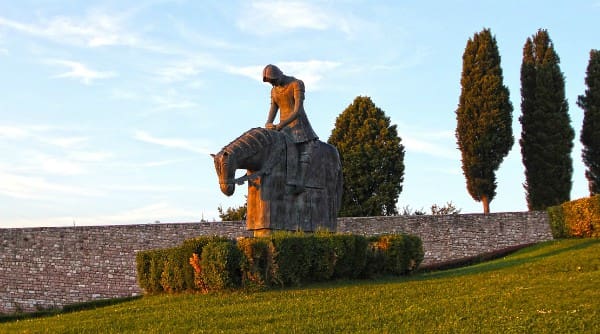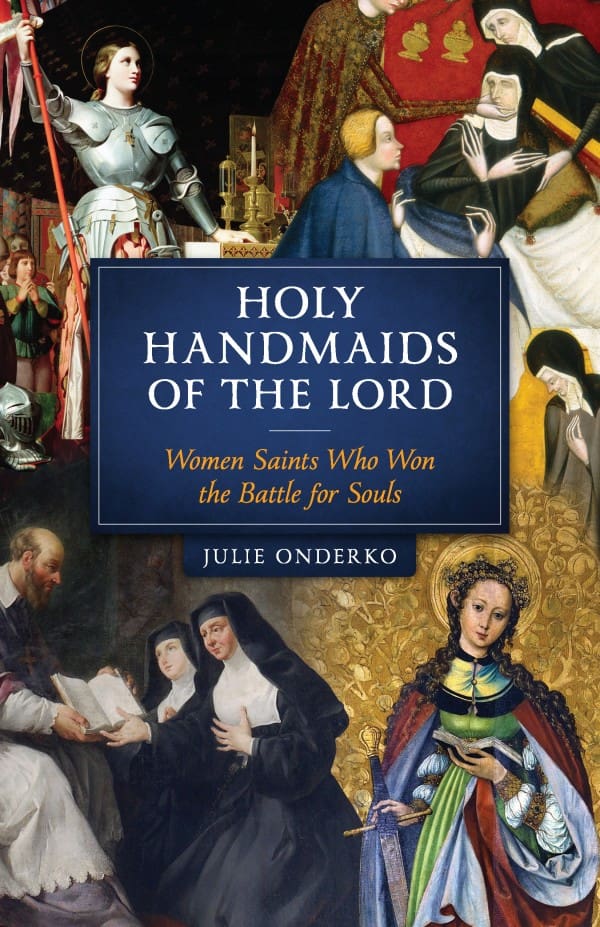Clare of Assisi (1193–1254) embraced God’s will for her life as the abbess of the cloister at San Damiano — she and her sisters were the female counterparts to Francis of Assisi’s new mendicant order, the Franciscans. Clare and the nuns were veiled from the world in the enclosure of the monastery, where they sustained the work of the Franciscans through their hidden life of poverty and prayer.
Clare abandoned her noble status and worldly possessions in order to answer the Lord’s call. This required a clandestine escape from her family home and her father, who had other plans for her life. Using the “door of the dead,” which was reserved for removing caskets, young Clare slipped out of her home during the night. To her, this was symbolic: she had died to her former life and would now live a new life in total dependence on God.
Clare made her way through the darkness to the Portiuncula Chapel, where she met Francis and his brothers. As an act of detachment and in reception of her new life as a bride of Christ, Clare allowed Francis to cut off her beautiful blond hair. With her shorn head veiled and wearing a rough tunic, Clare was escorted by the Franciscan brothers to a Benedictine convent, where she could stay until suitable arrangements could be made for her and the other women who would surely follow.
The walls of the Benedictine convent did not prevent Clare’s family from trying to rescue her. Her father, who had always made her decisions and intended to decide her future, could not understand why she would denounce her noble status to embrace the radical life of poverty offered by Francis. In the struggle to drag her from the convent, her veil was torn off, exposing her shorn head.
She pronounced boldly to her father, who was visibly shocked by her appearance, “The only spouse I will have is Christ, and further attempts to remove me from my chosen life will make me more steadfast!” Defeated, he left.
Others followed Clare, including her sister Agnes. Young women gave up what were considered promising futures with the accompanying titles and lands to embrace a cloistered life of poverty and total dependence on God. The sisters were set up in a modest house across from the Church of San Damiano. When Clare was twenty-two, Francis appointed her superior, giving her his rule to live by.62 The attraction to the Poor Clares, as they came to be called, continued to spread. During Clare’s lifetime, similar convents were established all over Italy and parts of France and Germany.
Warrior Mother
Clare hoped for martyrdom and wanted to give her ultimate witness for her Lord in the Holy Land. But martyrdom in the Holy Land was unrealistic for this virgin of Christ. But what if the opportunity for martyrdom came to her at the cloister of San Damiano? In 1240, the Saracens invaded Italy and were on their way to Assisi, where forty-seven-year-old Clare had been the abbess for almost twenty-five years.
The emperor Frederick II, in his ruthless expansion of territory, had been excommunicated by Pope Gregory IX, along with any man serving in his army. With no Christians willing to enlist, Frederick hired Saracens, Arab, and Muslim mercenaries. Villages were burned, and murders and atrocities were committed against the innocent and the defenseless. Monasteries were pillaged and destroyed, with unspeakable violations committed against nuns. Clare was sick in bed when word came that the Saracens were headed for San Damiano. There was no time to get help; the nuns were on their own. What is a mother to do when her daughters are in this kind of danger?
As ladders were being set to scale the walls of the convent, Clare, with assistance from her spiritual daughters, rose from her bed and went to our Lord, present Body, Blood, Soul, and Divinity in the Eucharist. In that desperate moment she prayed, “Does it please Thee, O God, to deliver into the hands of these beasts the defenseless children whom I have nourished with Thy love? I beseech Thee, good Lord, protect these whom now I am not able to protect.” Her prayer was immediately answered, and she heard, “I will have them always in my care.”
In the church of San Damiano, Clare and her spiritual daughters prostrated themselves on the floor in adoration before the Blessed Sacrament. The Eucharistic Lord was their hope and their strength. Given the history of the Saracens at other convents, impending tortures and executions were feared. Come what may, the Lord of the universe was with them. He would have the final word.
When the Saracens burst into the church, they were caught off guard. On the floor lay the nuns in adoration. The sisters did not react to the intrusion; their full attention was on the Lord. The Saracens, with their foul reputation, always provoked a response. But not this time. None of the sisters were running to escape. No one was preparing to defend themselves or fight. Not one woman was screaming in terror. The mercenaries were then overcome with awe and fear and they fled.
The Most Powerful Weapon of All
As we have seen demonstrated by Saint Clare of Assisi, spiritual weapons are confounding to the world but are powerful beyond space and time. Our Lord Himself offered His body on the Cross to defeat mankind’s worst enemy — death. At Calvary, Satan was soundly and definitively defeated. Jesus’ sacrifice is the greatest weapon against the devil.
We were not present at the Last Supper, the Crucifixion, or the Resurrection, but we are nonetheless invited to be there. God is outside of time, and at Holy Mass we enter into His once-forall sacrifice. We do not repeat it; rather, we participate in the Paschal Mystery. We are there.
During Mass, we are in the upper room at the Last Supper; we are at Calvary, the focal point of salvation history; we are peering into the empty tomb; and we are walking unknowingly with the hidden Jesus and the disciples on their way to Emmaus. Jesus said, “And behold, I am with you always, until the end of the age” (Matt. 28:20), and yet we know that He ascended to the Father, so how can this be? At Mass, our Lord is available to us in Holy Communion. We receive His Body, Blood, Soul, and Divinity, His presence, His “divine DNA.” The Church teaches: There is no surer pledge or clearer sign of this great hope in the new heavens and new earth “in which righteousness dwells,” than the Eucharist. Every time this mystery is celebrated, “the work of our redemption is carried on” (2 Pet. 3:13) and we “break the one bread that provides the medicine of immortality, the antidote for death, and the food that makes us live forever in Jesus Christ.”
Pope John Paul II wrote, “In reality Clare’s whole life was a eucharist because, like Francis, from her cloister she raised up a continual ‘thanksgiving’ to God in her prayer, praise, supplication, intercession, weeping, offering and sacrifice.” This seems a counterintuitive means of waging war with the devil, but it is exactly how Clare, warrior woman that she was, trounced Satan. It is a mystery involving women, beginning with the ultimate warrior woman, the Blessed Mother.
Mary, the woman spoken of in Genesis, whose “seed” would crush the head of the serpent, participates profoundly in the plan of salvation, including the mystery of the Eucharist, “the antidote for death and the food that makes us live forever.” The Body of Christ came from one woman, Mary; all His flesh, His entire humanity, came from His mother. The most powerful weapon against the infernal enemy of mankind came from a woman. The Blessed Virgin Mary is therefore caught up in the Eucharistic mystery:
[There is] no body and Blood in Him except hers. . . . “The Bread that I will give you is My flesh for the life of the world” (John 6:51). Who gave that flesh? He was conceived of a woman. St Ambrose: “The Body that we consecrate comes from the Virgin.”
Because of Mary’s fiat and through her maternity, we have the Eucharistic Jesus. The Christian who has just received Jesus in Holy Communion is therefore most feared by Satan and his demons. In a homily on the Eucharist, Saint John Chrysostom (349–407) makes this clear: “Let us then return from that table [having received the Body of Christ] like lions breathing fire, having become terrible to the devil.”
The Eucharist is the defeat of the devil. Clare of Assisi understood this spiritual truth and testified to it with her life. Our participation in the Holy Sacrifice of the Mass and our reception of the Eucharist opens heaven to us and renders Satan impotent.
+
This article is adapted from a chapter in Holy Handmaids of the Lord by Julie Onderko, which is available from Sophia Institute Press.
Art for this post on the Eucharist: Cover and featured image used with permission.





